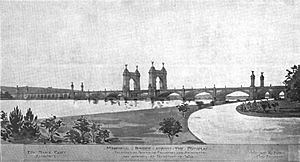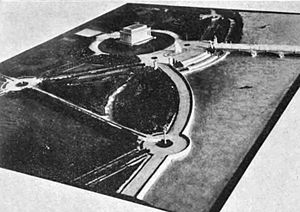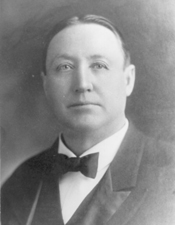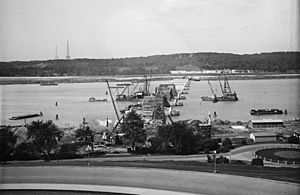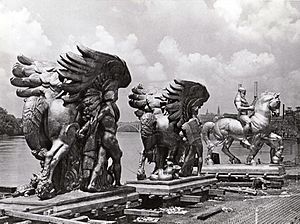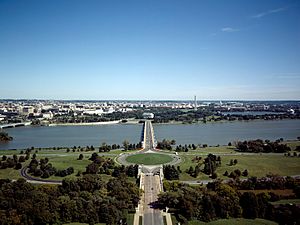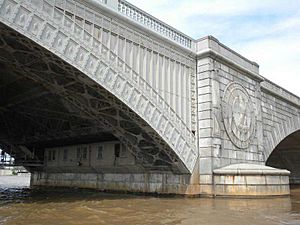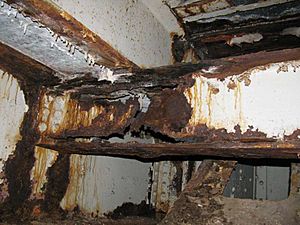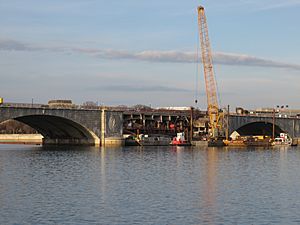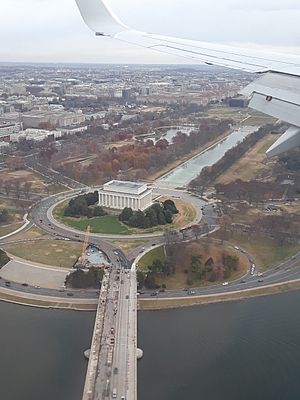Arlington Memorial Bridge facts for kids
Quick facts for kids Arlington Memorial Bridge |
|
|---|---|
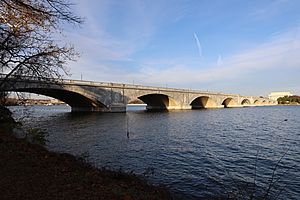
The bridge in December 2020, shortly after the completion of renovations
|
|
| Coordinates | 38°53′14″N 77°3′20″W / 38.88722°N 77.05556°W |
| Locale | Potomac River Washington, D.C. |
| Characteristics | |
| Total length | 2,163 ft (659.3 m) |
| History | |
| Architect | McKim, Mead, and White |
|
Arlington Memorial Bridge
|
|
| Architectural style | Neoclassical Central bascule Arch bridge |
|---|---|
| NRHP reference No. | 80000346 |
| Added to NRHP | April 4, 1980 |
The Arlington Memorial Bridge is a beautiful bridge in Washington, D.C.. It crosses the Potomac River and connects the capital to Arlington, Virginia. The bridge is made of stone and steel. It has a part in the middle that used to lift up like a drawbridge.
People first suggested building this bridge in 1886. But it took decades to build because of arguments. People disagreed about whether it should be a memorial and who it should honor. In 1921, a huge traffic jam happened during a special event for soldiers. This made leaders realize a new bridge was needed. They also wanted to finish it before George Washington's 200th birthday. So, the bridge was finally built in 1932.
The famous company McKim, Mead, and White designed the bridge. Sculptor Leo Friedlander added large statues showing bravery and sacrifice. These statues were made in Florence, Italy. The Arlington Memorial Bridge marks the western edge of the National Mall. The bridge's lifting part was closed for good in 1961. It was replaced in 2018 with a new section that does not open.
Contents
Why Was the Bridge Built?
Early Ideas for a Memorial Bridge
The idea for a bridge in this spot came up on May 24, 1886. The U.S. government wanted to study if a bridge could be built there. Later that year, a design for a 24-foot (7.3 m) wide bridge was suggested. The next year, the United States Department of War (now the Department of Defense) suggested naming it the "Lincoln-Grant Memorial Bridge." Some people even wanted to name it after both Robert E. Lee and Ulysses S. Grant.
Congress asked for another design. In late 1887, they proposed a "General Ulysses S. Grant Memorial Bridge." This new bridge would be a suspension bridge 105 feet (32 m) high. It would have 98 feet (30 m) of space underneath for boats. Early designs included a simple steel bridge and a fancy Roman-style one with big towers.
Because the bridge was meant to honor Grant, Congress often refused to give money for it. But after a study of the riverbed was done, Congress allowed $5,000 for a bridge design contest. Four well-known engineers were asked to submit ideas. A group chose a design by William H. Burr and architect Edward Pearce Casey. Their design was a drawbridge made of steel and stone. It had 36 arches and classical towers with statues of "Victory."
However, Senator George Frisbie Hoar stopped the bridge from being built in 1900. He did not like the design. Another group, the "National Memorial Bridge Association," then asked architect George Keller to create new plans. Keller's design was different. It was low to the water and did not have a drawbridge. It featured a large Roman-style arch on the D.C. side. It also had a memorial column on the Virginia side. This column celebrated the Union.
In 1901, the American Institute of Architects suggested extending New York Avenue NW over the Potomac River. This would connect it to Arlington National Cemetery. But Congress still did not act.
The McMillan Plan
In 1900, the U.S. Senate created a group called the Senate Park Commission. This group was formed to help plan the development of Washington, D.C. They especially focused on the National Mall. This plan is often called the "McMillan Plan" after Senator James McMillan. The commission shared its report on January 15, 1902.
The McMillan Plan suggested building a new main bridge and memorial at the western end of the National Mall. This area is also known as West Potomac Park. Much of this land did not exist before 1882. After a big flood in 1881, the Army Corps of Engineers deepened the Potomac River. They used the extra dirt to fill in the riverbanks. This created the land where West Potomac Park, East Potomac Park, and the Tidal Basin are today. This "reclaimed land" was mostly finished by 1890.
Congress did not officially approve the McMillan Plan. But they slowly started to follow it over the next few years. In 1910, Congress created the United States Commission of Fine Arts. This group of experts began to push for the bridge that the McMillan Plan had imagined. In 1913, Congress created the Arlington Memorial Bridge Commission. This group was supposed to choose a design for the bridge. However, World War I started, and no money was given to the commission. So, it did not do anything for a while.
Building the Bridge: 1922–1932
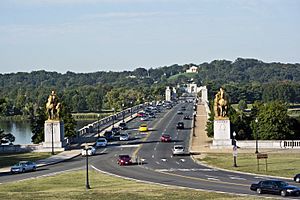
On November 11, 1921, President Warren G. Harding went to a ceremony. It was for the Tomb of the Unknown Soldier at Arlington National Cemetery. He got stuck in a three-hour traffic jam. The bridge he used could not handle all the cars. President Harding decided this should not happen again. In 1922, he asked for $25,000 to fund the bridge commission. Congress approved his request on June 12, 1922.
At first, the bridge commission suggested a different location for the bridge. But the Commission of Fine Arts (CFA) disagreed. They had the power to approve memorials. On December 18, 1922, President Harding and other leaders met. They all agreed to follow the McMillan Plan. This meant placing the bridge in a straight line between the Lincoln Memorial and Arlington House. They also agreed to build a low bridge with a drawbridge in the middle. This would let ships reach the Georgetown waterfront.
Choosing the Bridge Design
The bridge commission asked the CFA whether to hold a design contest. The CFA suggested picking a designer directly. They gave three names, including the firm of McKim, Mead, and White. The bridge commission chose McKim, Mead, and White on April 4, 1923. Architect William Mitchell Kendall was the main designer.
Businesses in Georgetown wanted to know if the bridge would have a draw span. They wanted large ships to reach their harbor. The Army Corps of Engineers said they would only approve a bridge with a draw span.
Kendall's first design was shown in May 1923. It was a low, classical arch bridge. It had statues on each pier. The D.C. side had a traffic circle around the Lincoln Memorial. This connected to the Potomac River with a plaza and steps. The CFA asked if the bridge could be wider, from 80 feet (24 m) to 100 feet (30 m). They also talked about a large traffic circle on Columbia Island. This circle would have a memorial to Robert E. Lee. Models of the bridge were put on display in February 1924.
Getting Approval from Congress
Senator Bert M. Fernald introduced a bill to build the bridge on April 25, 1924. The Senate approved the bill on December 30, 1924. But it faced more challenges in the House of Representatives. The House Committee approved the bill quickly. However, there was a lot of other work in the House.
Floor managers tried to get the bill approved on January 30. But the House voted to stop all bills except for spending bills. Later, the House passed the spending bills. This allowed the bridge bill to be considered on February 18. Many members of Congress were against the bill. They did not want their tax money to pay for a bridge in D.C.
Representative Louis C. Cramton suggested that D.C. should pay some of the cost. His idea passed. Other ideas, like making D.C. pay 60 percent or Virginia pay half, were defeated. Finally, the House approved the bill by a vote of 204 to 125. The Senate agreed to the changes on February 20. President Calvin Coolidge signed it into law on February 24, 1925.
In 1926, a government official stopped the contracts for the $12.5 million bridge. He said the law required hiring specific people, not a general contractor. In 1927, Congress changed the law so the work could continue.
Building the Bridge
The Arlington Memorial Bridge Commission managed the design and building of the bridge. The bridge unofficially opened on January 16, 1932. President Herbert Hoover was the first person to drive across it. He led a group of 12 cars to Mt. Vernon. This was part of George Washington's 200th birthday celebration.
At first, the bridge was only open during the day on Saturdays and Sundays. This was because it did not have lights. Also, the connections on the Virginia side were not finished. It opened for day and night use on May 6, 1932. This was after temporary lights were added.
The bridge is 2,163 feet (659 m) long. It cost $7.25 million to build. About $900,000 of that was for the center draw span.
Building the roads leading to the bridge in Virginia took six years. The National Capital Parks Commission wanted new roads. This would help create homes and jobs in Arlington County. Virginia and Arlington County officials discussed the costs. New roads were expensive because land had to be bought. This was a big concern during the Great Depression.
The bridge's draw span was the longest and heaviest in the world when it opened. It was also the fastest-opening.
About the Bridge
The bridge's D.C. end is near the Lincoln Memorial. The Virginia end is on Columbia Island. The D.C. end marks the western edge of the National Mall. The Virginia end connects to Memorial Drive. This road crosses the Boundary Channel Bridge into Virginia. It then leads to Arlington National Cemetery in Arlington County.
In 2011, about 54,000 vehicles crossed the bridge every day.
Bridge Design and Art
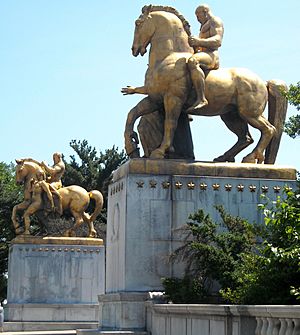
At the D.C. entrance to the bridge, you can see two large sculptures. They are called The Arts of War. These sculptures, Sacrifice and Valor, were finished by Leo Friedlander in 1951. One was made by the Ferdinando Marinelli Artistic Foundry in Florence, Italy. On the bridge's piers, there are large round designs. They feature eagles and fasces. Sculptor Carl Paul Jennewein designed them.
The closest Metro station is Arlington Cemetery. The bridge connects the Lincoln Memorial and Arlington House. This was done on purpose. It symbolizes the coming together of the North and the South after the American Civil War.
On the Virginia side, the bridge connects to the George Washington Memorial Parkway. It also connects to State Route 27 and State Route 110. On the D.C. side, it connects to Constitution Avenue, Independence Avenue, the Rock Creek and Potomac Parkway, and Interstate 66.
There is a special rule at the traffic circle on the Virginia side. Cars entering the circle have the right-of-way. This is the opposite of most traffic circles. During morning rush hour, part of the circle is closed. This helps prevent traffic jams.
The middle part of the bridge is a metal draw span. It was meant to let large ships pass upriver to Georgetown. But another bridge, the Theodore Roosevelt Bridge, was built upstream. It does not open. So, the drawbridge on Memorial Bridge was no longer needed. It last opened on February 28, 1961.
The Arlington Memorial Bridge was added to the National Register of Historic Places on April 4, 1980.
Bridge Repairs Over Time
The bridge was damaged by floods in March 1936. Water got into the electrical system. Repairs were made in late 1938 and early 1939. In October 1936, a gear in the drawbridge broke. The bridge was closed for nine hours for repairs. This was the longest closing since it opened.
Major repairs happened in 1939. The draw span was repainted. The bridge was repaved. The granite on the Virginia side was cleaned. This caused the bridge to close completely for six hours on three days.
In 1945, the bridge closed for two hours because the draw span got stuck. It closed again in August 1947. Workers replaced a part that stopped the draw span from shaking. The National Park Service (NPS) said this was the second-longest closing.
More major work happened in 1951. The granite blocks on the road were removed. The road was replaced with asphalt, which is safer. This $207,000 project began on July 16, 1951. Some lanes were closed during the week. The whole bridge closed on weekends for four weeks. Minor repaving happened again in July 1957.
Starting in March 1964, at least one lane was closed every day for draw span repairs. But the bridge never fully closed.
More work was done in November 1976. The draw span was fixed in place and sealed. The roads leading to the bridge were repaired. Three lanes were kept open during rush hour. At other times, only one lane in each direction was open. These repairs lasted several weeks.
A big repair project happened in the summer of 1985. It involved repaving the bridge and updating its safety features. This $4.7 million project closed two lanes in each direction. The work began in April 1985 and finished on September 25.
In January 2011, workers repaired the bridge's sidewalks. This closed two lanes in each direction during non-rush hours. The center lanes closed for a few days in March 2012 for more work. In June 2012, Cianbro Corp. worked on an eight-week, $788,000 project. They repaired the bridge's deck, curbs, and sidewalks.
Even with these projects, the bridge had not had a complete overhaul by 2012. That year, a report said the bridge needed a full renovation.
Inspections and Lane Closures
In February 2013, the Federal Highway Administration (FHWA) started a big inspection. In April, a park service official said the bridge was "beyond its life cycle." The inspection found the bridge was in "poor condition." There was rust on the steel and cracks in the concrete. Metal flakes were falling from the steel beams. The drainage system was also clogged.
The Washington Post reported that trucks and buses might be banned from the bridge. This would happen if repairs were not made soon. Officials said a full reconstruction could start by 2016. Repair costs were estimated to be $125 million to $250 million.
In January 2015, the FHWA and NPS said the bridge was safe for traffic. But they warned that it was getting worse quickly. The draw span was in especially bad shape.
On May 15, 2015, the National Park Service suddenly closed one lane. They needed to check for serious rust. The inspection found corrosion on the draw span. Engineers decided it was not safe for cars to use the outer lanes. So, these two lanes were closed on May 28, 2015. They also set a weight limit of 10 short tons (9.1 t) per vehicle. This meant most buses could not cross. Parts of the sidewalks were also closed.
These closures were expected to last six to nine months. Workers would strengthen the rusted beams. Cianbro Corp. won a $2.5 million contract for these repairs. The work began in late August or early September 2015. This work would allow lanes to reopen but not remove the weight limit.
In July 2016, officials announced a two-phase repair plan. The first phase would fix the most urgent problems. It would cost $166 million and keep the bridge open until 2030. The second phase would replace the draw span and cost $94 million.
On July 5, 2016, the U.S. Department of Transportation gave a $90 million grant. This money would help start the repairs.
Major Renovation
On November 30, 2017, a big renovation of the bridge was announced. The project cost $227 million. It was paid for by different government funds. Kiewit Infrastructure won the contract. The work included replacing the draw span, repairing the roads leading to the bridge, and replacing the deck. Construction started in 2018. The newly renovated bridge fully reopened on December 4, 2020.
Images for kids



